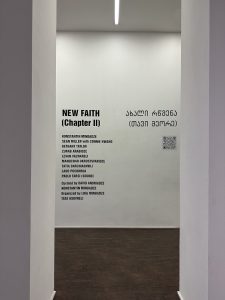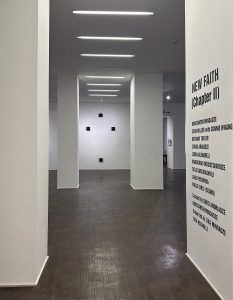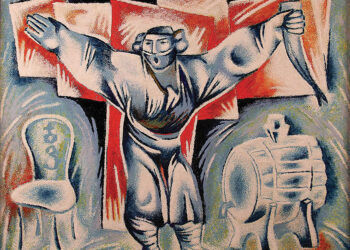An expanded version of previous 8 artist exhibition project “New Faith” this time envisaged for MOMA Tbilisi is divided in three sections. The exhibition, opened in the Zurab Tsereteli Museum of Modern Art, reflects upon lifecycle itself: birth, adulthood and death.
A person can never know death directly. He might, only wonder at it if and whenever meets briefly; Or, in a Heideggerian way, he might rush into death in advance. But this “preliminary run” does not necessarily lead to death itself. It is an ecstatic human condition, which at the same time implies a kind of tragic-comic simulacrum.
Neither man can meet God face to face. – This is a pre-meeting, a kind of “path” – prospecting.
Creating a preliminary idea of the (a)theological space, where a person engaged in divine abandonment can be temporarily resided.
The participants of the project will lead us to this kind of room, where they ask ‘God’ one question; Or they ask a question in the name of God, which is also a question about the future of their personal “Self”.
Here, in this “black room”, a person abandons all his identity, and m-eanwhile the language, robbed of any conceptual content, no longer responds to existence.
Here a human is only obsessed with the question; a question, as an ecstatic state, which temporarily ceases existence and only with a quasi-metaphysical apperception yearns for handling time, or death.
And this time is absolutely dead time thus far. – Or, it is the life that lives the dead time.
David Andriadze

Expanded version of previous 8 artist exhibition project “New Faith” this time envisaged for MOMA Tbilisi is divided in three sections and reflects upon lifecycle itself: birth, adulthood and death. First section viewer enters is “Birth”, here you will find Konstantin Mindadze’s recent large scale work on unstretched linen titled “Interdependent & IN-dependent” (after Albert Camus – Jonas) alongside with recent works like “AI (biggest boon of all is not to be born at all”, “Alien (trident)” and new murals like “Church (aka swastika)”, “Lost Soul (aka star upside down) and “Silence that does not exists (aka wave)”, which comes in dialog with Bethany Taylor’s two tapestries, called “Silence” and “Against the Reckless”. In the same section there are two recent drawings by Manuchar Okrostvaridze, along with his sculpture titled “Cultural penis penetrating public opinion”. Lado Pochkhua’s fragmented photographic work of “young boy pointing gun” responds to the risks of childhood. In the far corner of the same area is presented Sean Miller’s physical scroll installation this time along with video and broken replica of real Meteorite with “cosmic dust” scattered around. “Freedom” by Zurab Arabidze and “An unpleasant sensation that signals real or possible pain” (aka Thorn) are also parts of the first area.
Before entering the second section “Adulthood” viewer passes Levan Vaznareli’s analog photographic works damaged by fungi, that give us association as if the images are taken during some strange lightning or explosions.
In the second section first work viewer comes in contact with is Zurab Arabidze’s Installation “Utopian hatmony of the system (Imbalance of consciousness)” paired with 15 min. video “Chilli winter is expected” (aka House with bricked windows) consisting of steel construction accompanied with single channel video, the work gives you a feeling of danger and fear of war and in a way responds to Manuchar Okrostvaridze’s sculptural diptych “Content Unavailable”. In the same section you will find Tatia Darchiashvili’s 360 degree painted steel sculpture “Inner Time” along with its’ large scale painting of traced silhouettes. Further in the same section you come across Konstantin Mindadze’s sequence of 21 drawing “Y to T” together with its’ large scale shaped linen, medium scale triptych and micro animation – all reflecting on self-transformation processes and growth.
And finally, viewer enters the “Death Room” or the “Dark room of Questions”; there you may see two sculptures by Konstantin Mindadze, large white lightbox called “Binary Crucifixion” along with red cross lightbox in steel cage and two Video/Animation Projections: “Candy Inside” (transparent coffin with dark fluid matter”) and on opposite side “SVN Skull animation after Marcel Proust. As the last work in the dark room there is an audio installation as the collaborative piece of work: each participant had recorded “One question to God” and is looped as a sound, the same questions are written randomly by each participant with a glow paint in the dark room on the dark walls.
Konstantin Mindadze















